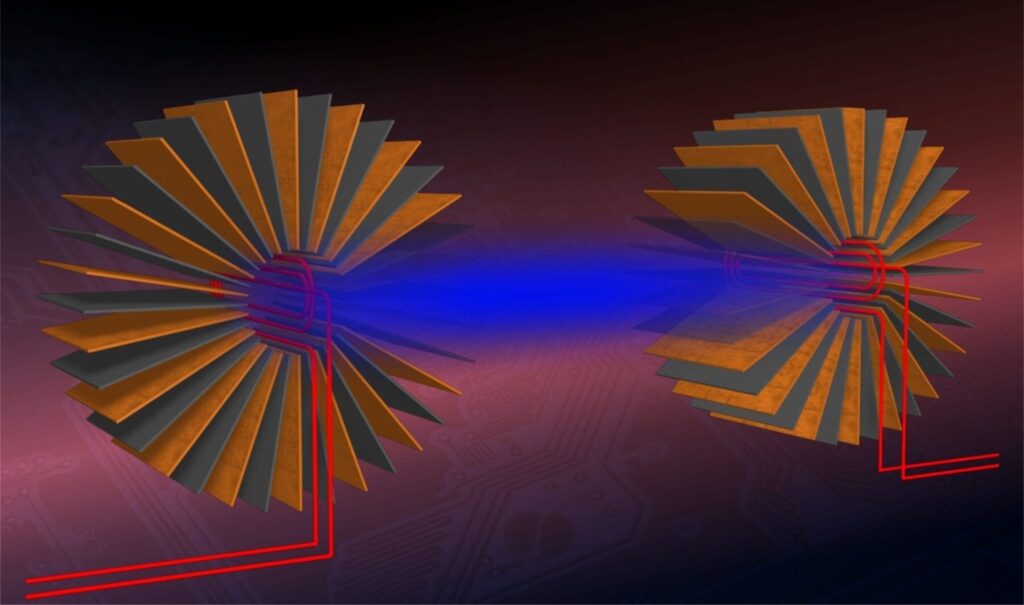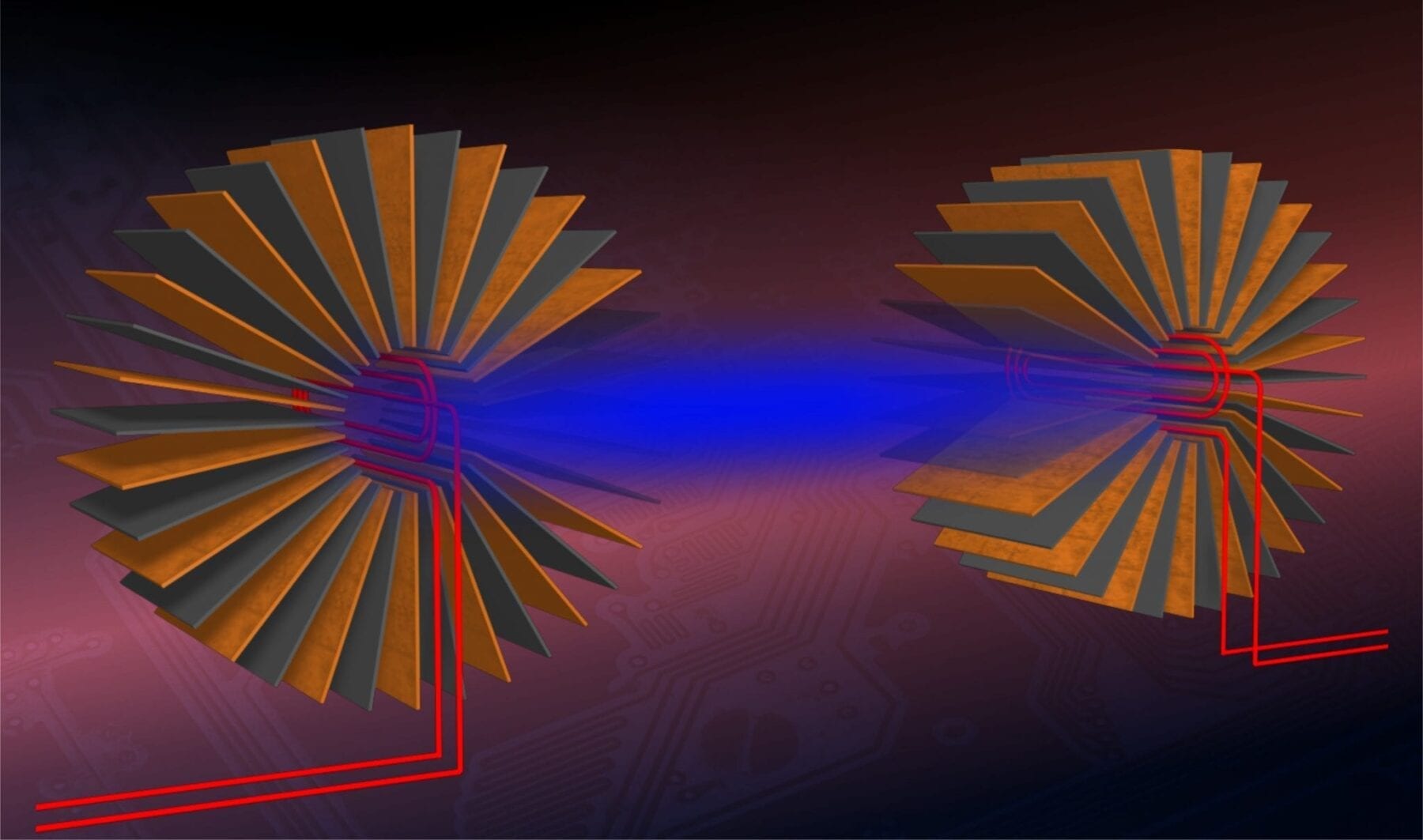
Universitat Autònoma de Barcelona researchers have developed a system which efficiently transfers electrical energy between two separate circuits. The system, made with a shell of metamaterials which concentrates the magnetic field, could transmit energy efficiently enough to charge mobile devices without having to place them close to the charging base.
The research was published in the journal Advanced Materials.
Wireless charging of mobile devices is possibly one of the most desired technological milestones. Some devices can already be charged wirelessly by placing the mobile device on top of a charging base. The next step, charging devices without the need of taking them out of one’s pocket, might be just around the corner.
A group of researchers from the Department of Physics of Universitat Autònoma de Barcelona has developed a system which can efficiently transfer electrical energy between two separated circuits thanks to the use of metamaterials. This system is still in the experimental stage, but once it has been perfected and can be applied to mobile devices, it will be able to charge them wirelessly and at a longer distance than currently possible.
Today’s wireless devices make use of induction to charge through a special case adapted to the device and a charging base connected to an electrical socket. When the device is placed on top of the base, this generates a magnetic field which induces an electric current inside the case and, without the need of using any cables, the device is charged. If the device is separated from the base, the energy is not transferred efficiently enough and the battery cannot be charged.
The system created by UAB researchers overcomes these limitations. It is made up of metamaterials which combine layers of ferromagnetic materials, such as iron compounds, and conductor materials such as copper. The metamaterials envelop the emitter and receiver and enable transferring energy between the two, at a distance and with unprecedented efficiency.
With the use of metamaterial crowns researchers were able in the lab to increase the transmission efficiency 35-fold, “and there is much more room for improvement, since theoretically the efficiency can be increased even more if conditions and the design of the experiment are perfected” explains Àlvar Sánchez, director of the research.
“Enveloping the two circuits with metamaterial shells has the same effect as bringing them close together; it’s as if the space between them literally disappears”, states Jordi Prat, lead author of the paper.
Moreover, the materials needed to construct these crowns such as copper and ferrite are easily available. The first experiments conducted with the aim of concentrating static magnetic fields required the use of superconductor metamaterials, unfeasible for everyday uses with mobile devices. “In contrast, low frequency electromagnetic waves – the ones used to transfer energy from one circuit to the other – only need conventional conductors and ferromagnets”, Carles Navau explains.
Learn more: Distance Wireless Charging Enhanced by Magnetic Metamaterials
The Latest on: Distance Wireless Charging
[google_news title=”” keyword=”Distance Wireless Charging” num_posts=”10″ blurb_length=”0″ show_thumb=”left”]
via Google News
The Latest on: Distance Wireless Charging
- Tesla Wireless Charging: Is It Possible And When It Will Happenon April 28, 2024 at 4:59 am
Tesla is actively exploring wireless EV charging, eliminating cables for streamlined, efficient charging, once again revolutionizing the EV landscape.
- Best Wireless Charging Phones (April 2024) in Indiaon April 26, 2024 at 5:00 pm
Wireless charging is a novelty feature of high-end smartphones but is seldom seen in mid-range devices. You've found the right place if you're in the market for a phone that works with this handy ...
- Infinix Note 40 Pro: A game-changing mid-range smartphone with battery and charging innovationon April 26, 2024 at 1:11 am
The Infinix Note 40 offers next-generation battery and charging features along with design enhancements at a competitive price point.
- How Wireless Charging Is Advancing to Make Power Cords Obsoleteon April 24, 2024 at 11:00 am
Wireless charging is seeing rapid innovation that is making it faster and more efficient. We break down how the technology works and what it could mean for a range of devices and accessories beyond ...
- Will induction charging solve EV range anxiety?on April 23, 2024 at 9:04 pm
While almost all EVs have relied on wired charging solutions, in which drivers plug in a cable to recharge the car’s battery, wireless charging has the potential to make EV ownership more convenient, ...
- Belkin Launches New Qi2 Wireless Charging Range In Australiaon April 22, 2024 at 7:53 pm
American consumer electronics brand, Belkin, has launched its new Qi2 collection of wireless chargers in Australia and New Zealand. The range consists of the BoostCharge Pro 2-in-1 Magnetic Pad, the ...
- Belkin launches its new Qi2 range of faster wireless chargerson April 22, 2024 at 6:43 pm
Belkin has released its latest range of Qi2 charging products which includes the BoostCharge Pro 2-in-1 Magnetic Pad, the BoostCharge Pro Convertible Magnetic Stand and the BoostCharge Pro 3-in-1 ...
- Android 15 to come with NFC-based wireless charging support: All you need to knowon April 22, 2024 at 6:34 am
As anticipation builds for the official unveiling of Android 15 at Google I/O 2024, the prospect of NFC-based wireless charging represents a significant leap forward in charging technology. If ...
- Best Wireless Headphones for TV in 2024on April 21, 2024 at 7:00 pm
Ever found yourself turning the volume up because your home's hustle and bustle drowns out your favorite TV shows? If so, consider investing in a good pair of wireless headphones to allow you to enjoy ...
- Best wireless earbuds for travel, workouts and multitaskingon April 18, 2024 at 1:56 am
Discover the very best wireless earbuds with our carefully selected list, full of high quality and budget-friendly options, plus advice from audio experts.
via Bing News











